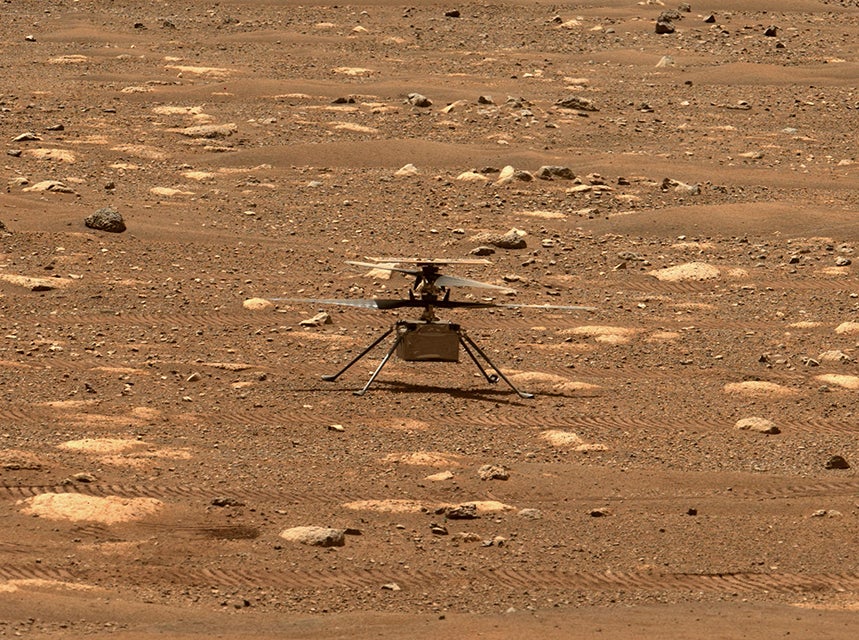connect
Developing Perseverance
Alumni innovations built in Mars rover, helicopter
EDIT.jpg) IMAGE: NASA/JPL-CALTECH; Inset image of crystal component: Courtesy of G&H Ohio
IMAGE: NASA/JPL-CALTECH; Inset image of crystal component: Courtesy of G&H Ohio
 IMAGE: NASA/JPL-CALTECH/ASU
IMAGE: NASA/JPL-CALTECH/ASU Top image: An illustration of the Perseverance rover on Mars. Inset is a crystal component in the rover’s SuperCam that CWRU alumni and colleagues developed at G&H, Cleveland.
Bottom: The Ingenuity helicopter unlocked its rotor blades in April, allowing them to spin freely. Ingenuity’s Qualcomm flight platform includes the chip that an alumnus and his former colleagues helped develop.
NASA's Perseverance Rover took about seven months to travel from Cape Canaveral, Florida, to Mars. But for Case Western Reserve alumni who helped develop components for the vehicle and Ingenuity, the 4-pound mini-helicopter, that traveled with it to Mars, the journey began many years ago. Think spoke to a few alumni who worked for supplier companies that helped power the intrepid explorers.
Deep Reflection
The crystals three alumni helped grow for the mission weigh less than a pound and are about the size of two packs of playing cards.
But the crystals are nonetheless tasked with a big job: helping the rover unlock the planet's past. They were developed by Katie Colbaugh (CWR '13; GRS '15, materials science and engineering), Matt Whittaker, PhD (CWR '96; GRS '00, '07 materials science and engineering), Robert Kidwell (CWR '18), and other colleagues at G&H, Cleveland. Now the crystals are vital components of the SuperCam mounted on the top of Perseverance.
The SuperCam functions as an optical geologist of sorts, able to determine the chemical composition of elements on Mars' surface by aiming a laser at a desired target.
The crystals filter the resulting light reflections, enabling scientists to identify the object's chemical makeup.
"If you know what an object is being illuminated with and then measure the light that comes back off that object, you'll find that there are wavelengths missing," Whittaker said. And that's what allows for chemical identification.
Growing such crystals from seeds takes painstaking precision and extremely high temperatures, with growth chambers sometimes exceeding 1,000 degrees centigrade).
It also takes patience, with development taking up to two years.
Watching the Mars landing was exciting, but also nerve-wracking, Whittaker said with a laugh. "I guess we felt like we had more at risk there than the average person."
Powered Up
More than six years ago, Venkata "Raja" Gosula (CIT '85; GRS '87, electrical engineering and applied physics) led digital development of a chip to manage cellphone power. When Perseverance landed on Mars, Gosula started getting texts from former colleagues that their Qualcomm chip was part of the company's processor helping to power the Ingenuity mini-helicopter. Qualcomm said the chip also is in Perseverance.
Ingenuity's unprecedented purpose is to show that flying on another planet is possible. NASA officials have described it as a "Wright brothers moment" for space exploration. In April, Ingenuity began a series of flight tests, potentially leading the way for future copters to explore areas of Mars unreachable by a rover.
But Gosula didn’t assume his former co-workers’ texts were correct.
"I had to investigate to make sure it was true," Gosula said. He did remember the chip, having led a 10-person team of engineers to build out its digital capabilities; it eventually managed power on several cellphone models, including some in the popular Samsung Galaxy line. Gosula is now at Cisco Systems Inc., in the San Diego area with a leading role in building chips that accelerate optical connections within big data centers that contain thousands of computers.
"I always feel lucky when my products are sold all over the world, knowing that the thing I designed is humming everywhere," Gosula said. "And then to find out that something that you did is actually humming on another planet—on Mars? That’s just too much."





